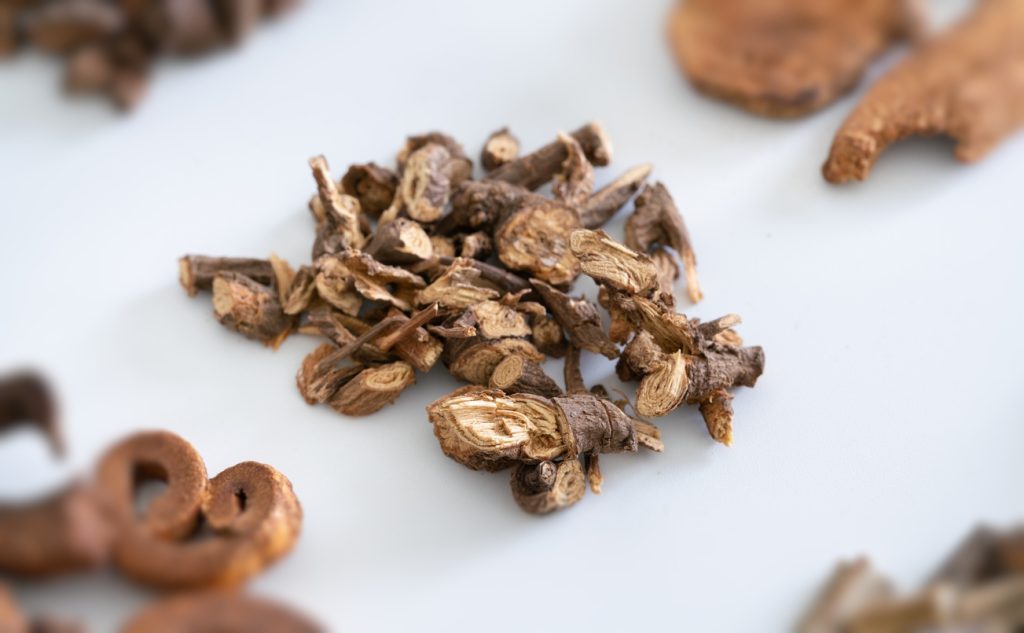Radix Bupleuri (Chai Hu)

What is Radix Bupleuri (Chai Hu)?
Radix Bupleuri (chai hu, 柴胡), also known as Bupleurum Chinense or Chinese Thorowax Root, comes from the family of Bupleurum, a genus of mostly perennial plants. This genus is native to East Asia, made up of nearly 200 species. Bupleurum plant is an upright growing plant that has yellowish-green petals arranged in groups of five, and its roots are often dried, ground into powder and used medicinally.
In Traditional Chinese Medicine (TCM), Chai Hu belongs to the category of ‘Cool/Acrid herbs that release the Exterior’. Such herbs can treat the early stages of diseases that affect the upper respiratory tract, eyes, ears, nose, throat or skin. In TCM, it is believed that external diseases such as colds or allergies can only invade our body if the external environment overwhelms our wei qi (immune system). In order to address this invasion, Cool/Acrid herbs that release the exterior induce sweating by dilating our capillary pores to expel the diseases from the body.
Cool in nature, the Chai Hu herb can help individuals who have too much Heat in their body, such as those experiencing a Yang Excess or a Yin Deficiency, to restore a healthy yin-yang balance. Bitter in taste, the herb can cleanse the body by clearing Heat, drying Dampness and promoting elimination via urination or bowel movements. In particular, the herb targets the gallbladder and the Liver.
Functions and Benefits of Radix Bupleuri (Chai Hu)
Traditional Chinese Medicine (TCM) shows that Radix Bupleuri has the following health benefits.
Radix Bupleuri can expel external pathogens to release the exterior, which helps to relieve exterior symptoms such as high fever, cold sweats, thirst and bitter taste in the mouth.
Radix Bupleuri is also a popular herb in the treatment of Liver depression with qi stagnation. This syndrome is often manifested as distending pain in the rib area or abdomen, gastric pain, stress, depression, stomach burning, poor appetite, restlessness, dizziness, vertigo or irregular menstruation. Radix Bupleuri can be combined with other qi-promoting, Liver-soothing, blood-activating or pain-relieving herbs to strengthen its effects.
Radix Bupleuri can ascend the yang qi of the Spleen and the stomach, which then helps to treat symptoms such as diarrhoea, rectum prolapse, hemorrhoids and other symptoms caused by Spleen Deficiency or the sinking of middle qi. In addition, the herb may help to address malaria.
Modern studies discovered that Radix Bupleuri contain active ingredients such as saponins and plant sterols, which have been shown to lower fever and reduce inflammation in animal studies. The herb is also suggested to be able to strengthen the stomach, intestines and promote blood circulation to the liver. Due to its ability to reduce inflammation, Radix Bupleuri may also strengthen one’s immune system.
Radix Bupleuri may help to manage diabetes by preventing neuropathy through reducing blood sugar levels and inflammation. In an animal study, mice with diabetes were given Radix Bupleuri for 2 days, and they experienced reduced blood sugar levels and increased insulin levels. However, more research is required to fully understand the effects of the herb on humans’ blood sugar levels.
Radix Bupleuri contains active components called saikosaponins. Existing studies have demonstrated that these components can help our body by acting as antivirals, improving sleep quality, facilitating autophagy and reducing the sensation of pain. In addition, as Radix Bupleuri is high in potassium, it can help to support adrenal fatigue, boost mood and improve emotional wellbeing.

How to Use Radix Bupleuri (Chai Hu)
To release exterior symptoms and relieve fever, Radix Bupleuri should be used in its unprocessed form. To soothe the Liver and ease depression, Radix Bupleuri can be processed with vinegar. To address ascending yang, Radix Bupleuri can be used unprocessed or prepared with alcohol.
Radix Bupleuri is often used as part of a larger, more complex herbal formula. The recommended dosage of Radix Bupleuri depends on the exact condition being treated. For general usage, many healthcare practitioners recommend 1.5 – 6g of dried Radix Bupleuri in a decoction.
Cautions and Side Effects of Radix Bupleuri (Chai Hu)
Radix Bupleuri should not be used by individuals who are experiencing Liver Fire that is ascending to the head. Pregnant or breastfeeding ladies and patients with high blood pressure should stay away from this herb for the time being as well.
Also, overconsuming Radix Bupleuri may cause nausea, vomiting or diarrhoea due to its high saponin content. Other side effects include increased bowel movement and drowsiness.
Individuals with internal body Heat symptoms such as night sweating, hot flushes, or constant thirstor those who display hypertensive related symptoms should avoid Chai Hu.
Summary
Here is a summary for Radix Bupleuri (Chai Hu):
- Herb name (Chinese): 柴胡
- Herb name (Pin Yin): chái hú
- Herb name (English): Chinese Thorowax Root
- Herb name (Botanical): Radix Bupleuri
- Origin of species: Bupleurum chinense DC.; Bupleurum scorzonerifolium Willd.
- Part(s) of herb used: Root
- Geo-specific habitat(s): Hebei, Henan, Liaoning, Hubei, Shaanxi, Sichuan, Anhui, Heilongjiang, Jilin
- Taste(s) & Properties: Bitter, pungent; Slightly cold; Administrates the Gall Bladder and Liver Meridians
- Actions: Relieves mild symptoms of common flu and related respiratory ailments; Eases emotional distress and helps to relieve menstrual conditions; Helps to relieve conditions relating to prolapse of uterus or rectum
References
Li, Z. Y., Sun, H. M., Xing, J., Qin, X. M., & Du, G. H. (2015). Chemical and biological comparison of raw and vinegar-baked Radix Bupleuri. Journal of ethnopharmacology, 165, 20-28.[Accessed on 6th December 2022]
Yang, F., Dong, X., Yin, X., Wang, W., You, L., & Ni, J. (2017). Radix Bupleuri: a review of traditional uses, botany, phytochemistry, pharmacology, and toxicology. BioMed Research International, 2017. [Accessed on 6th December 2022]
Yuan, B., Yang, R., Ma, Y., Zhou, S., Zhang, X., & Liu, Y. (2017). A systematic review of the active saikosaponins and extracts isolated from Radix Bupleuri and their applications. Pharmaceutical biology, 55(1), 620-635. [Accessed on 6th December 2022]
Share this article on
